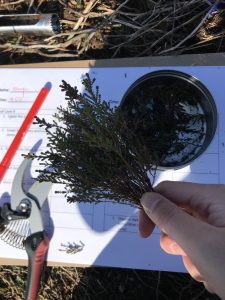Written by Kerryn Little
Fuel moisture content (the amount of water in vegetation) is critical for predicting wildfire behaviour, fire ignitions and wildfire danger. Monitoring fuel moisture directly is an intensive process that may be necessary for research in environments where fuel moisture dynamics are not fully understood or captured by existing models. Researchers at the University of Birmingham have carried out intensive fuel moisture sampling campaigns to understand cross-landscape and cross-region fuel moisture dynamics. This has required many pairs of hands to capture the variability at the plot, landscape and regional scales.
Groups of volunteers enabled three large-scale fuel sampling campaigns to be conducted within the United Kingdom. We focused on sampling live and dead Calluna vulgaris (commonly called heather), moss, litter and organic material. Heather is an important fuel for wildfire behaviour in temperate peatland and heathland ecosystems that is not well represented by existing fuel models.
 Figure 1: Calluna vulgaris (common heather), illustrated by Andy Slator.
Figure 1: Calluna vulgaris (common heather), illustrated by Andy Slator.
Plot Scale: Fuel Moisture Field Course
Undergraduate geographers at the University of Birmingham completed a one-day field campaign in the Lickey Hills Country Park, Birmingham to monitor diurnal variability in fuel moisture content. Students collected samples and then dried them in the laboratory on campus. Research-centric education can provide a great opportunity to fully involve students in the research process, towards addressing real research problems.
Landscape Scale: North Yorkshire Moors National Park Wildfire Surveyors
The North Yorkshire Moors National Park Authority has a strong volunteer network. To understand spatial and temporal fuel moisture dynamics, a Wildfire Surveyor group was formed with volunteers from this community. Volunteers received training and equipment to collect fuel moisture samples during targeted campaigns, thereby also setting the foundation for a future community-led wildfire danger monitoring network.
Figure 2: North Yorkshire Moors Wildfire Surveyor collecting heather samples.
Regional Scale: UK-wide Volunteer Campaign
We are now exploring a UK-wide sampling campaign, where volunteers will sign up to collect and post fuel samples to analyse regional fuel moisture dynamics during high fire weather conditions in spring 2023. Such citizen science research provides opportunities for the wildfire community to address research questions across broad spatiotemporal scales.

Figure 3: Fuel moisture sampling equipment.
Accounting for Sampler Bias
Having multiple samplers creates an inevitable situation where sampler bias contributes to the variability in measurements as people naturally interpret instructions differently. It is important to consider this variability in large-scale field campaigns to improve the relevance of fuel moisture content measurements generated.
Citizen science research has led to an improved understanding of fuel moisture dynamics at the plot, landscape and regional level by allowing the collection of data at scales not typically possible in individual field experiments. The wildfire community could further benefit from the careful implementation of citizen science research to address other research questions requiring the collection of data across large spatiotemporal scales.



This is a great initiative to understand across the UK the fuel moisture dynamics and to get the wider community involved. The outcomes of this work will be essential for ensuring the UK is more resilient to wildfires in the future. Having a snapshot of fuel moisture in Spring 2023 will be a great step in obtain this essential information for UK wildfire modelling and hopefully more experiments of this kind can be continued with this volunteer network established. I am looking forward to being a part of this citizen science community and have volunteered some time for areas of NW England. I think there is still chance to get involved, so if you haven’t signed up do so, as this is a great opportunity to be involved in the first experiment of this kind in the UK. Thanks to University of Birmingham and PyroLife for co-ordinating this in support of the wildfire community.